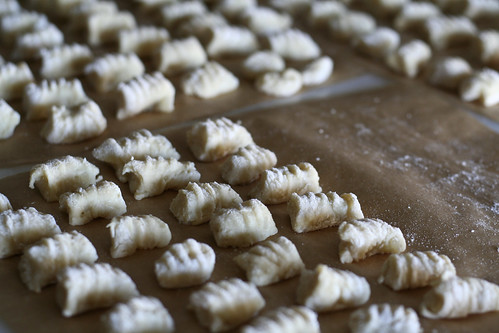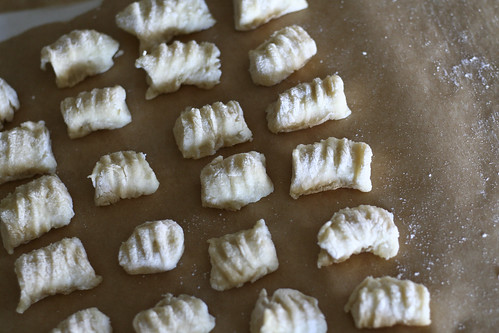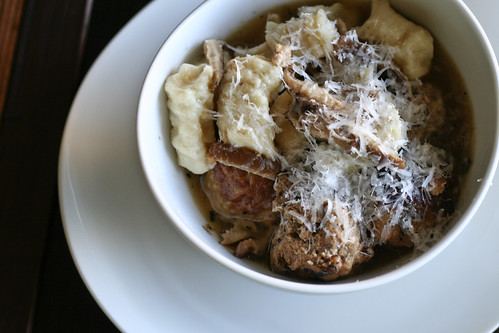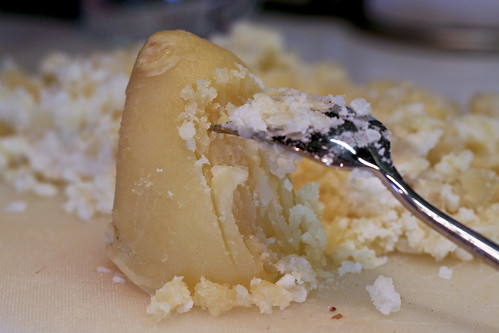how to make homemade gnocchi

Have you ever tasted homemade gnocchi? I’m not talking about the stuff that’s shrink-wrapped and powdery in the pasta isle of your grocery store. Not that I’m knocking store-bought gnocchi — it’s perfect for quick weeknight meals and satisfies the potato pasta craving. But there’s nothing like real, this homemade gnocchi. They’re much less dense than the pre-packaged kind — soft and pillowy, physician like a dumpling, but still as sturdy and chewy as you’d expect.
I was first introduced to homemade gnocchi when I was a mere pre-teen punk. My parents were close friends with an Argentinian couple who made them once a month. In Argentina, it’s tradition to make gnocchi on the 29th of each month and serve them with a dollar bill placed under the plate to attract prosperity (more over at Wikipedia). I can’t remember how the gnocchi tasted, but I remember it was good. Delicious, even.

I made an enormous batch this weekend as a special Sunday Supper for Tom’s birthday and served them with lamb and veal ricotta meatballs in a hearty Parmesan and shitake broth (recipe for those later this week). While making gnocchi may not be for the beginner cook, they’re not as difficult as you might think. Just keep a box of pasta in the pantry in case something goes wrong.

The most difficult thing about making gnocchi is that measurements are a rough guideline and you’ll have to go by feel for a lot of this. There are a lot of variables that make giving precise measurements tricky — potato sizes vary, egg sizes vary, altitude affects dough, etc. So, here’s a rough recipe, along with tips and pointers for getting your dough just right. I encourage you to give these a try. Unlike fresh pasta, fresh gnocchi is much more difficult to find at the store and definitely worth the extra effort for homemade.
Update: Forgot to mention that I froze 2/3 of the gnocchi I made since it was a double batch and only 5 people came for dinner. (I always make too much.) To freeze fresh gnocchi, just cover the parchment paper with another sheet of parchment and roll it up like a fruit roll-up or sushi roll. Gently place the rolled parchment into a gallon-sized freezer bag and seal, making sure you push as much air out of the bag as possible. The layers of parchment will prevent them from sticking together or getting freezer burn when they freeze.
How to Make Homemade Gnocchi
I served my gnocchi with lamb and veal ricotta meatballs in a hearty Parmesan and shitake broth. These would be great pan-fried in a bit of butter or olive oil, or tossed with roasted pumpkin, olive oil, sage and pumpkin seeds for a lovely fall dish. Your favorite pesto sauce or light marinara sauce also work well here.
Fresh gnocchi can be frozen* and the recipe can be doubled if you’d like to make a big batch on a weekend, freeze the excess and cook them up in more reasonable portions. Just toss the frozen gnocchi into boiling water and they’re done when they float.
2 large russet potatoes
1 1/4 cup all purpose flour (or cake flour)
1 tsp. sea salt
2 extra large eggs, beaten until combined
Halve the potatoes (skin on) and place them in a large pot of salted water over high heat. Allow the water to come to a boil and let cook until the potatoes are completely tender, but not water-logged, about 35 – 40 minutes. Remove the potatoes to a cutting board with a slotted spatula and reserve the water.
While they’re still hot, peel and fluff the potatoes one at a time. I find that you can peel the skin right off with your fingertips. Be careful not to burn yourself. Place each potato cut-side down and peel each potato half, then run the tines of a fork down the sides to fluff it up (see photo). You don’t want to mash the potato with your fork or a potato masher because that will make for more dense gnocchi. You want them light and airy.

Once you’ve fluffed the potato halves, transfer them to a floured work surface and let the potatoes cool a bit. You want them to still be warm, but not so warm that eggs will cook once mixed in.
When your potatoes are the right temperature, sprinkle with about 3/4 cup of flour. Mix the salt into the eggs and pour those on top too. This is going to get messy :)
Using your hands or a pastry scraper (I like to use my hands) begin kneading everything together until evenly combined. You want your dough to start off like mashed potatoes and slowly become less sticky as the flour incorporates. Keep sprinkling the dough with flour until it’s no longer sticky. Make a big dough ball.
Now, your ready to form the gnocchi. Place a large sheet of parchment paper (or plastic wrap) next to your work surface. Pull a piece dough off the dough ball the size of a baseball, or your fist. Place on a floured surface and sprinkle with a bit more flour. Roll the dough out into a long, round piece the shape of a breadstick.
Using the side of a fork, cut a small rectangular piece off. Size doesn’t matter here. You want your pieces to be small-ish (bite-sized), but they don’t have to be uniform in size. Don’t worry about cooking time – gnocchi tells you when its ready. Now, hold the gnocchi on it’s small sides with one hand, and gently roll the back of your fork tines over the top to create the traditional gnocchi shape. You can skip this step and just have smooth gnocchi, but I recommend you try it. Your gnocchi don’t have to be perfect – rustic is good here.
Lay the gnocchi on your prepared parchment paper as you go. When your gnocchi are ready to boil, add more water to the potato water so that you have a nice, full pot. Return the water to a rapid boil and add more salt. Add the gnocchi in batches of 20 or so. You know they’re done when they start to float. Fish them out of the pot with a slotted spatula or spoon as soon as they float and transfer them to a bowl. You may want to add a little olive oil to the bowl to prevent them from sticking, but I usually eat the right away and they don’t stick together.
Serve with your favorite sauce.
Makes 4 – 6 servings.
*To freeze fresh gnocchi, just cover the parchment paper with another sheet of parchment and roll it up like a fruit roll-up or sushi roll. Gently place the rolled parchment into a gallon-sized freezer bag and seal, making sure you push as much air out of the bag as possible. The layers of parchment will prevent them from sticking together or getting freezer burn when they freeze.